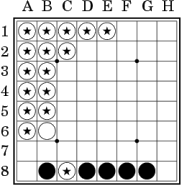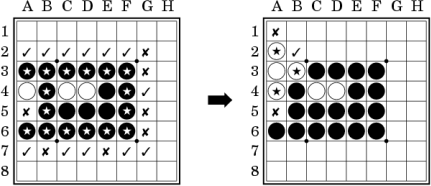
Stable (or definitive) discs may not be flipped anymore. The importance of such discs is obvious. Peculiarly, Discs in the corners are always definitive. Some examples of definitive discs (red star):

The process of accumulating definitive discs generally leads to an easy victory. It is thus recommended to avoid playing naively the X squares or the C squares, which give access to the corners.
Real mobility is the number of (legal) moves available to a player. Many choices improve the opportunity to get a good move. On the other hand, lacking of choices may force you to play a bad move, an X square for example, thus losing a corner. So, the correct way of playing consists in increasing your own mobility while decreasing opponent's mobility.
The potential mobility is a more abstract principle. It concerns the neighbourhood relationship between discs and empty squares, in order to anticipate the real mobility in the next moves. Indeed, an empty square touching an opponent discs, even though it is not playable immediately, will probably become playable in a near future. Discs touching empty squares make the frontier. A correct behaviour is to reduce your own frontier, and also the numbers of empty squares around your discs.
In the next example, White reaches an excellent real and potential mobility (left figure): 12 legal moves (yellow marks) + 7 potential moves (green stars), in contrast with the huge black frontier, spreading over 16 discs (red crosses). After White choose A2, Black's mobility remains awkward (right picture): White keeps his frontier marginal with only 3 discs (red crosses); so, Black has got only 2 potential moves (green star) and, worst, a single legal move (yellow marks), at B2, an X square! Forced to play that bad move, Black may nor prevent A1 in the next move, neither a large Black's win

In close games, with an almost equal number of discs for both sides, the last player who makes a move has an obvious advantage when, doing his last move, he flips just enough discs to win the game. A game being made of 60 moves, the one playing the even moves get this advantage. Thus, at the beginning of the game, White owns the parity. But, whenever a player passes his turn, parity changes of side.
Local parity is a principle very important at the end of the game. Empty square holes, usually around the corners, help to understand who is going to win the parity, and, surely, the game. For example, if two empty squares are surrounded of discs belonging to a single player, we may expect his opponent to be the first to play there, immediately followed by a move of the former player who finally flipped more discs than his opponent. So, generally speaking, playing a odd hole is better than playing an even hole.
In the first example, Black can only play in even holes. After each one of his move, White answers in the same hole, finally winning the game 37 to 27:

In the second example, Black can play in odd holes. Inside each hole, Black will be able to play twice, against only once for White, forced to pass. As a results, Black win 34 to 30:

Similarity between the two previous examples, different only about the local parity, confirms the importance of this concept.
Once you feel comfortable with all the above elements of strategy, only practice will make you progress more.




Ajax version 1.3 (05/09/2001 00:00)
Copyright © 2000 Richard Delorme
All right
reserved.
Othello ® is a registered trademark of Tsukuda-Original,
licensed by Anjar and distributed
in France (and some other countries) by Mattel.